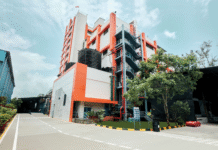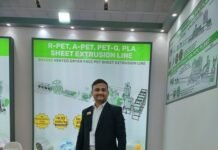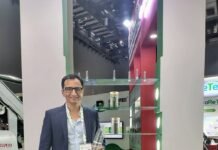Anantshree Chaturvedi is the 32-year-old vice chairman and chief executive officer of Flex Films International. Educated in Finance, Global Strategic Management and Economics at Babson College, he is currently based out of the company’s office in New York and is in charge of UFlex’s international operations. He has already taken on several global leadership responsibilities for the group, including research and development and product development, while honing a business philosophy that will change the company’s future from being a flexible packaging and polymer science company to a product development and material science company. Naresh Khanna of Packaging South Asia conducted the interview by eMail and telephone.
Naresh Khanna – Anantshree Chaturvedi, what is your role as chief executive officer and vice-chairman of Flex Films and what are some of the specific tasks that you have taken on in the immediate future and perhaps in the next year?
Anantshree Chaturvedi – As the vice chairman and chief executive officer, I am completely responsible for the North, South and Latin America regions, so the entire P&L of these regions report to me. I also look after large macro projects such as product development, product launch process, product deployment, R&D, administration, human resources as well as general corporate governance across the Uflex family of companies.
One of the pivotal tasks that I have taken up is to revamp the research and development and the product launch process, which is Flex Film’s unique version of the stage gate product development process. I am also restructuring and reorganizing the central corporate governance and HR infrastructure within the organization. It is my job to transition a project-based company, to a product- and process-based company. I will lead this change and ensure that Flex commits itself to making more refined and complex products while getting rid of the complexity that results from making large-scale and less flexible projects. Our products are aimed to make the customer’s life simpler, while our projects are designed to refine the customer experience. This is a sea change from simply being a large volume manufacturer that once focussed on building as many plants globally as possible.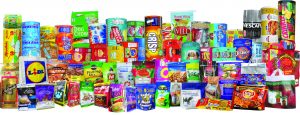
PSA – Where do you see growth in the global and South Asian context for the group and when are you planning to set up your second plant in the US? In an earlier interview with us, you mentioned that perhaps the earliest and most likely investment would be in the Poland film plant. Is there any news of this happening? Also, do you see any potential for Uflex investments in Latin America or opportunities closer to home in South East Asia and the Far East?
Anantshree Chaturvedi – I see a significant amount of growth for the Uflex group both domestically within India and Asia overall, because there is certainly a massive population which consumes a large amount of packaged products in South Asia as well as the surrounding Asian markets. From a global perspective, our strongest assets are Poland and Egypt, and in a few weeks we will be looking into making an announcement on our expansion plans.
Regarding our investment in Poland or the US, or Latin America for that matter, we are very close to making a decision and will be able to share the details with the readers of Packaging South Asia in the next few months.
Our next projects will be aimed towards increasing the variation and augmenting the strengths of our product portfolio, not necessarily increasing the general volume of our products. We have spent a significant amount of time consolidating our strengths over the last couple of years, trying to reorient ourselves to supply the market with exactly what it needs. The biggest example I can give you is of our recently inaugurated and commissioned aseptic liquid packaging material manufacturing plant in Gujarat. You will see more and more plants with those kinds of capabilities coming.
We are aggressively pursuing these markets. However, to again emphasize my earlier point, I am looking to expand in these markets with unique products, and not necessarily for geopolitical advantage or any kind of first-mover advantage, which is what we have previously done in our Poland, Mexico, and UAE facilities.
PSA – Tell us a bit more about how you see consolidation in the industry. Are you only considering acquisitions or would you even look at divesting any part of the company’s portfolio?
Anantshree Chaturvedi – Our view is that the industry will head towards a strategic consolidation over the next 7 to 10 years. Currently, many new players have become operational, both within the film side as well as the converting side of the business, although both segments are fragmented at very different levels. We notice that there is a global consolidation wave in the converting side of the business that has come to India as well. In the next 5 to 10 years, a similar consolidation will likely take place globally on the film side and we want to be in a prime position for executing mergers and acquisitions.
Flex is looking actively towards acquisitions. We have been aggressively pursuing the acquisition of a few companies over the last couple of years and Uflex is evaluating all M&A options that will further enhance its leadership position in the value-added flexible packaging segment. Not only would this bring significant geographic advantage to us but will also bring product advantage. Our finance team has enhanced its skill set in readiness for M&A opportunities that may arise. However, once again, we are not looking to do this for volumes, but more from a product focus side.
In terms of divestment we are not actively seeking to divest any part of the business. However, if the right offer came about, we would consider it. Currently, all parts of our business are profitable and pointing towards growth, so I can’t isolate and talk about divesting a single unit because they are all on strong paths. All of them also have an essential synergy that allows Flex to shine in the markets that we participate in. So it is very hard for me to say that we are going to divest.
PSA – Recently Uflex has come up with several interesting machines from its engineering division but we believe that this is still a small part of the company’s turnover. Given the push toward automation and Industry 4.0, do you see an opportunity to accelerate the growth of equipment manufacture or will this remain a secondary or subsidiary activity?
Anantshree Chaturvedi – Uflex Engineering is a small yet profitable part of Uflex. I don’t regard it personally as a secondary business. I think it is a primary business vertical and with the kind of volume and the kind of numbers that it displays, it has a lot of advantages. Of course, looking at the overall group, it has remained a small part of our business and that has been done strategically because we are focused on making machines that give unique advantages to our customers as well as providing an exceptional service standard to our current and ever-growing customer base.
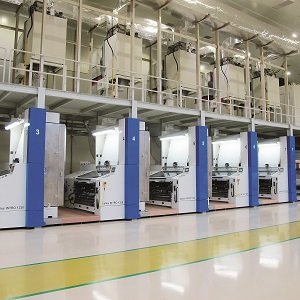
new Uflex Asepto plant in Sanand.
Photo PSA
We have taken a keen interest in Industry 4.0. In the current move towards automation and in the next couple of years we will see a significant sea change in how basic machinery, even on a large scale industrial level gets deployed and utilized. We are doing a lot of research and development to not only validate but also perfect the right level of functionality, robustness, and standardization of products that our machines will provide. There are a couple of cross division projects at play currently that will change the business model of Uflex Engineering significantly. However, it is a little too soon for me to discuss that on the record.
PSA – Having just visited the new Uflex Asepto liquid packaging plant in Sanand, it is clear that the company is extremely ambitious to enter new areas at the global level with state-of-the-art technology and infrastructure investments. Can you speak a bit more about the liquid packaging project and also other possible ideas for the remaining three-fourths of the land at the Sanand site?
Anantshree Chaturvedi – The aseptic liquid packaging project is yet again another example of Uflex taking on a massive challenge and utilizing a gap that exists in the market to provide a niche solution to large set of customers who have not imagined a different way to package liquids in flexible packaging containers for the last 40 years. Asepto is the start of a new era of not only products, but of a business philosophy that will change the future of Uflex from being a flexible packaging and polymer science company to a product development and material science company.
The state-of-the-art production facilities of Asepto are the latest and best example of a philosophy that Uflex has always followed – never buy a used machine, when you can buy a new one. Also, never buy old technology when a new one exists or is on the cards to be implemented and deployed in the future. This combined with our product creation philosophy is what enables Uflex to take on ambitious and groundbreaking challenges.
With regards to the remainder of the three-fourths of the land at Sanand, Gujarat there are certainly many businesses within Uflex that are interested in expanding in that space. My estimate is that the most profitable businesses – holograms, chemicals, and engineering might get the right of first refusal to go into the rest of the land. However, nothing is really off the table including new ideas and concepts that Uflex is currently working on.
PSA – To come back to flexible packaging where Uflex is able to focus on innovative solutions, what are some of the innovations aimed at decreasing spoilage in the Indian food supply chain and food exports? Do you believe that Uflex engineers and scientists can take on packaging problems in the advanced consumer supply chains of Europe and America? If so, why is this desirable and what are some of your insights as to how it could happen?

Anantshree Chaturvedi – Flexible packaging for the food industry is based on the principles of decreasing and eliminating the levels of water and oxygen that seep into a packaged food. The same two elements are essential for human beings to grow healthy cells and maintain a healthy lifestyle. Hence, the packaging business is facing a dichotomy when it comes to refining their product properties because human beings are aiming to eat more fresh food today and less packaged food. Uflex firmly believes that our packaging is currently enabling consumers in all markets, Asian, Eastern as well as Western to eat more fresh food and eat food that is cooked and prepared within a 24 to 48 hour period, rather than food that is prepared and consumed weeks or sometimes even months apart.
Keeping that philosophy in mind, I would like to just like to mention modified atmospheric packaging and the Flex Fresh range of products that are, in quotes, a ‘living example of this philosophy.’ In conjunction with that, the kind of solutions that are required for logistics supply chains in the Asian markets are quite different from what is actually required in the Western markets.
In the Asian markets such as India, cold chain supply systems are rare and realistically, also erratic if not prohibitive in their implementation and deployment. Keeping that in mind, the Indian market requires much more robust and higher packaging combined with packaging that can handle a significantly larger amount of wear and tear than its counterparts in the West. In the West a cold chain supply chain is much more common and refrigeration from plant to shelf or from food facility to shelf adds a layer of protection that is hard to augment or enhance using packaging. Hence, our research philosophy is of doing research and development separately for the Indian and Asian markets, from that for the western markets — since products that are required in either of these markets are significantly different.
Keeping this in mind, I am very confident about the ability of Uflex’s scientists in India to take on separately, the advanced consumer trends of Europe and America because my research teams operate out of Europe and America for those markets and there is nothing that says it better to R&D than being a local consumer yourself. As Steve Jobs said, “Someone who always says, ‘The customer is always right’ was probably never a customer.” The best way to be right about what your customer wants is to be a customer yourself. You learn how to part with your hard earned cash within the market that you are consuming in.
The research process in the Eastern and Western markets is already producing significant positive momentum for Uflex’s current product portfolio diversification and strengthening drive. Our product portfolio change over the next couple of years in itself, will be the best living example of how this philosophy plays out.





